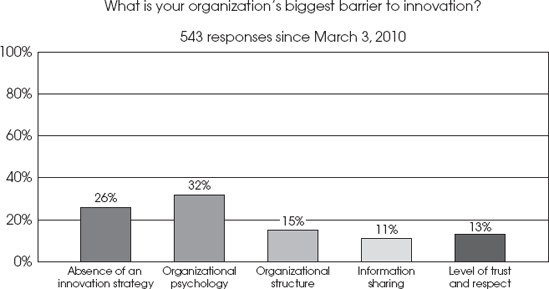Epilogue
Now that you've read the whole book (I hope), I thought I would leave you with the results of a poll that I conducted on LinkedIn (see Figure E.1 through E.6), along with some of the comments:
Every stakeholder in the organisation has good education and understanding of the need for innovation—take for example NHS system. Everyone has great backgrounds, but has a lack of will to do the necessary actions. This is my argument for trust and respect is the reason that innovation fails. | ||
| --—Niels-Peter Thoms | ||
Although limited resources are a key barrier, the underlying cause for a weak innovation program is the lack of leadership commitment to the hard work required for meaningful innovation. If the commitment was there, the resources would be abundant. | ||
| --—George Cugini | ||
Our organization is used to strong leadership so the psychology of taking a risk and moving forward with innovation at the worker level is scary. In addition, although we have a strategy, we haven't implemented enough tools and processes so employees feel like they understand how to move forward. | ||
| --—Karen Bradbury | ||
Information sharing is the key barrier. Lack of knowledge sharing and using the existing knowledge, I always say "If we only knew what we know, innovation would go a lot faster." | ||
| --—Nel Mostert | ||

Figure E.1. Biggest Barrier to Innovation
Figure E.2. Barrier Job Title
Figure E.3. Poll Barrier Function
Figure E.4. Poll ...
Get Stoking Your Innovation Bonfire now with the O’Reilly learning platform.
O’Reilly members experience books, live events, courses curated by job role, and more from O’Reilly and nearly 200 top publishers.

